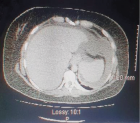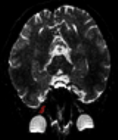Abstract
Research Article
Epilepsy due to Neurocysticercosis: Analysis of a Hospital Cohort
Olivier Mukuku*, Marcellin Bugeme, Adjratou Djeynabou Sow, Athanase Millogo, Oscar Numbi Luboya and Kamadore Touré
Published: 24 September, 2020 | Volume 4 - Issue 2 | Pages: 063-068
Introduction: Neurocysticercosis (NCC) is a common helminthic infection of the nervous system that occurs when humans become intermediate hosts in the life cycle of the pig tapeworm (Taenia solium) after ingesting its eggs. The objective of this study was to analyze socio-demographic, clinical and paraclinical features of patients with NCC in Lubumbashi, DRC.
Methods: This is a cross-sectional study conducted over a period of 2 years within the Neuropsychiatric Center of Lubumbashi. Socio-demographic, clinical, paraclinical and therapeutic features were studied.
Results: A total of 18 patients with NCC were listed. Epilepsy was found in 72.2% (13/18) of the cases. The mean age of the patients was 30.2 ± 13.5 years; males accounted for 61.2% of the cases. 84.6% were consumers of pork. Generalized epilepsy was found in 84.6% of the cases and hypereosinophilia in 38% of the cases. On the neuroimaging, the parietal location of lesions represented 92.3%; calcifications were the type of lesion in 53.8% of the cases and 69.2% of the cases presented lesions in the 4th evolutionary stage. Electroencephalogram was normal in 84.4% of the cases. Phenobarbital was the antiepileptic drug used in 69.3%; albendazole and prednisone were used in 53.9% of the cases.
Conclusion: This study shows that NCC is one of the causes of epilepsy in Lubumbashi. Generalized tonic-clonic seizures are the most common form of presentation and calcified parenchymal lesions are the most common radiological feature of NCC. So, any patient with acute onset of afebrile seizure should be screened for NCC provided other common causes been ruled out.
Read Full Article HTML DOI: 10.29328/journal.jnnd.1001036 Cite this Article Read Full Article PDF
Keywords:
Epilepsy; Neurocysticercosis; Lubumbashi
References
- Medina MT, De Giorgio CM. Introduction to neurocysticercosis: a worldwilde epidemic. Neurosurg Focus. 2002; 12: 1.
- Lescano AG, Garcia HH, Gilman RH, Gavidia CM, Tsang VCW, et al. Taenia solium cysticercosis hotspots surrounding tapeworm carriers: clustering on human seroprevalence but not on seizures. PLoS Negl Trop Dis. 2009; 3: e371. PubMed: https://pubmed.ncbi.nlm.nih.gov/19172178/
- Garcia HH, Nash TE, Del Brutto OH. Clinical symptoms, diagnosis, and treatment of neurocysticercosis. Lancet Neurol. 2014; 13: 1202–1215. PubMed: https://pubmed.ncbi.nlm.nih.gov/25453460/
- Sotelo J, Guerrero V, Rubio F. Neurocysticercosis: a new classification base on active and inactive forms. A study of 753 cases. Arch Intern Med. 1985; 145: 442–445. PubMed: https://pubmed.ncbi.nlm.nih.gov/3977513/
- Carabin H, Ndimubanzi PC, Budke CM, et al. Clinical manifestations associated with neurocysticercosis: a systematic review. PLoS Neglected Trop Dis. 2011; 5: e1152. PubMed: https://pubmed.ncbi.nlm.nih.gov/21629722/
- Scharf D. Neurocysticercosis. Two hundred thirty-eight cases from a California hospital. Arch Neurol. 1998; 45: 777–780.
- Bugeme M, Mukuku O. Neurocysticercose révélée par une épilepsie réfractaire: à propos d’une observation. Pan African Med J. 2015; 20: 104. PubMed: https://www.ncbi.nlm.nih.gov/pmc/articles/PMC4458307/
- Newton CR, Garcia HH. Epilepsy in poor regions of the world. The Lancet. 2012; 380: 1193-1201. PubMed:https://pubmed.ncbi.nlm.nih.gov/23021288/
- Montano SM, Villaran MV, Ylquimiche L, et al. Neurocysticercosis: association between seizures, serology, and brain CT in rural Peru. Neurology. 2005; 65: 229–233. PubMed: https://pubmed.ncbi.nlm.nih.gov/16043791/
- Carter JA, Neville BG, White S, et al. Increased prevalence of epilepsy associated with severe falciparum malaria in children. Epilepsia. 2004; 45: 978–981. PubMed: https://pubmed.ncbi.nlm.nih.gov/15270766/
- Annegers JF, Hauser WA, Beghi E, Nicolosi A, Kurland LT. The risk of unprovoked seizures after encephalitis and meningitis. Neurology. 1988; 38: 1407–1410. PubMed: https://pubmed.ncbi.nlm.nih.gov/3412588/
- Del Brutto OH, Santibanez R, Idrovo L, et al. Epilepsy and neurocysticercosis in Atahualpa: a door-to-door survey in rural coastal Ecuador. Epilepsia. 2005; 46: 583–587. PubMed: https://pubmed.ncbi.nlm.nih.gov/15816956/
- Mukuku O, Nawej P, Bugeme M, Nduu F, Mawaw PM, et al. Epidemiology of Epilepsy in Lubumbashi, Democratic Republic of Congo. Neurology Research International. 2020; 2020.
- Del Brutto OH, Arroyo G, Del Brutto VJ, Zambrano M, García HH. On the relationship between calcified neurocysticercosis and epilepsy in an endemic village: A large scale, computed tomography–based population study in rural Ecuador. Epilepsia. 2017; 58: 1955-1961. PubMed: https://pubmed.ncbi.nlm.nih.gov/28850668/
- Winkler AS, Blocher J, Auer H, Gotwald T, Matuja W, Schmutzhard E. Epilepsy and neurocysticercosis in rural Tanzania—an imaging study. Epilepsia. 2009; 50: 987-993. PubMed: https://pubmed.ncbi.nlm.nih.gov/19054402/
- Del Brutto OH, Nash TE, White AC, Rajshekhar V, Wilkins PP, et al. Revised diagnostic criteria for neurocysticercosis. J Neurol Sci. 2017; 372: 202-210. PubMed: https://pubmed.ncbi.nlm.nih.gov/28017213/
- Fisher RS, Acevedo C, Arzimanoglou A, Bogacz A, Cross JH, et al. Définition clinique pratique de l’épilepsie. Epilepsia. 2014; 55: 475-482. PubMed: https://pubmed.ncbi.nlm.nih.gov/24730690/
- Duchene M, Benoudiba F, Iffenecker C, Hadj-Rabia M, Caldas JGMP, Doyon D. La neurocysticercose. J Radiol. 1999; 80: 1623-1627. PubMed: https://www.ncbi.nlm.nih.gov/pmc/articles/PMC4458307/
- Kabeya-Kabenkama J, Tshikwela M L, Mpoyo-Mukendi W, Said-Mutena E. Neurocysticercose à Kinshasa: imagerie et clinique à propos de 11 cas. J Radiol. 2007; 88: 1443. PubMed: https://www.ncbi.nlm.nih.gov/pmc/articles/PMC4458307/
- Shrestha B, Mainali P, Sayami S, Shrestha O K. Clinico-radiological aspects of neurocysticercosis in pediatric population in a tertiary hospital. J Nepal Med Assoc. 2013; 52.
- Miranda LP, Zambrana MM. Frequency of epilepsy in patients with neurocysticercosis, in the service neurology and neurosurgery mother-child hospital. J Neurol Sci. 2015; 357: e456. PubMed: https://www.ncbi.nlm.nih.gov/pmc/articles/PMC1736787/
- Garcia HH, Gilman R, Martinez M, Tsang VC, Pilcher JB, et al. Cysticercosis as a major cause of epilepsy in Peru. The Cysticercosis Working Group in Peru (CWG). Lancet. 1993; 341:197–200. PubMed: https://www.ncbi.nlm.nih.gov/pmc/articles/PMC2917763/
- Nsengiyumva G , Druet‐Cabanac M, Ramanankandrasana B, Bouteille B, Nsizabira L, et al. Cysticercosis as a major risk factor for epilepsy in Burundi, East Africa. Epilepsia. 2003; 44: 950-955. PubMed: https://pubmed.ncbi.nlm.nih.gov/12823579/
- Sonhaye L, Tchaou M, Amadou A, Assih K, Kolou B, et al. Valeur diagnostique de la tomodensitométrie dans la cysticercose cérébrale à Lomé. Pan African Med J. 2015; 20: 67. PubMed: https://www.ncbi.nlm.nih.gov/pmc/articles/PMC4450042/
- Garcia HH, Pretell EJ, Gilmann RH, Martinez SM, Moulton LH, et al. A trial of antiparasitic treatment to reduce the rate of seizures due to cerebral cysticercosis. N Engl J Med. 2004; 350: 249-258. PubMed: https://pubmed.ncbi.nlm.nih.gov/14724304/
- Fleury A, Dessein A, Dumas M, Preux PM, Tapia G, Larralde C. Symptomatic human neurocysticercosis: age, sex and exposure factors relating with disease heterogeneity. J Neurology. 2004; 251: 830-837. PubMed: https://pubmed.ncbi.nlm.nih.gov/15258785/
- Mwang’onde BJ, Chacha MJ, Nkwengulila G. The status and health burden of neurocysticercosis in Mbulu district, northern Tanzania. BMC Res Notes. 2018; 11: 890. PubMed: https://pubmed.ncbi.nlm.nih.gov/30545404/
- Millogo A, Nitiéma P, Carabin H, Boncoeur‐Martel MP, Rajshekhar V, et al. Prevalence of neurocysticercosis among people with epilepsy in rural areas of Burkina Faso. Epilepsia. 2012; 53: 2194-2202. PubMed: https://pubmed.ncbi.nlm.nih.gov/23148555/
- Zafindraibe NJ, Ralalarinivo J, Rakotoniaina AI, Maeder MN , Andrianarivelo MR, et al. Séroprévalence de la cysticercose et facteurs de risque associés chez un groupe de patients vus au Centre Hospitalier Régional de Référence d’Antsirabe, Madagascar. Pan African Med J. 2017; 28. PubMed: https://www.ncbi.nlm.nih.gov/pmc/articles/PMC5989193/
- Andriantsimahavandy A, Ravaoalimalala VE, Rajaonarison P, Ravoniarimbinina P, Rakotondrazaka M, et al. Situation épidémiologique actuelle de la cysticercose à Madagascar. Arch Inst Pasteur de Madagascar. 2003; 69: 46-45.
- Ndiaye A, Niass MD, Diouf M, Faye N. Profil épidémiologique des parasitoses digestives au centre d'analyse du centre hospitalier Abass Ndao de 2011 à 2012. Open Sci Repos Med. 2014. e23050482.
- Fain A, Limbos P, Van Ros G, De Mulder P, Herin A. Présence du cestode raillietina celebrensis chez un enfant originaire de Tahiti. Ann. Soc. Belge Méd Trop. 1977; 57: 137-142.
- Paugam A. Parasitoses et atteinte neurologique. Revue Francophone des Laboratoires, 2008; 399: 41-53.
- Sil A, Das K, Das NK, Chakraborty D, Mazumdar G, et al. Use of anti-epileptic drugs in a tertiary care hospital of Eastern India with emphasis on epilepsy due to neurocysticercosis. Indian J Pharmacol. 2012; 44: 106-110. PubMed: https://pubmed.ncbi.nlm.nih.gov/22345881/
- Cruz ME, Schantz PM, Cruz I, Espinosa P, Preux PM, et al. Epilepsy and neurocysticercosis in an Andean community. Int J Epidemiol. 1999; 28: 799-803. PubMed: https://pubmed.ncbi.nlm.nih.gov/10480714/
- Moyano LM, Saito M, Montano SM, Gonzalvez G, Olaya S, et al. Neurocysticercosis as a cause of epilepsy and seizures in two community-based studies in a cysticercosis-endemic region in Peru. PLoS Neglected Tropical Diseases. 2014; 8: e2692. PubMed: https://pubmed.ncbi.nlm.nih.gov/24551255/
- Prasad KN, Prasad A, Gupta RK, Nath K, Pradhan S, et al. Neurocysticercosis in patients with active epilepsy from the pig farming community of Lucknow district, north India. Transactions of the Royal Society of Tropical Medicine and Hygiene. 2009; 103: 144-150. PubMed: https://pubmed.ncbi.nlm.nih.gov/18804830/
- Sciutto E, Fragoso G, Fleury A, Laclette JP, Sotelo J, AlujaA,et al. Taeniasolium disease in humans and pigs: an ancient parasitosis disease rooted in developing countries and emerging as a major health problem of global dimensions. Microbes Infect. 2000; 2: 1875—1890. PubMed: https://pubmed.ncbi.nlm.nih.gov/11165932
- Rajaonarison P, Ralamboson S, Andriamamonjy C, Ramanampamonjy R, Ramanantoanina CE, et al. Diagnostic de la neurocysticercose: à propos d'un cas. Archives de l'Institut Pasteur de Madagascar. 2001; 67: 53-56.
- Almeida CR, Ojopi EP, Nunes CM, Machado LR, Takayanagui OM, et al. Taenia solium DNA is present in the cerebrospinal fluid of neurocysticercosis patients and can be used for diagnosis. European archives of psychiatry and clinical neuroscience. 2006; 256: 307-310. PubMed: https://pubmed.ncbi.nlm.nih.gov/16816897/
- Ky H, Van Chap NG. Aspects radiocliniques de la cysticercose cérébrale et musculaire: A propos de 20 observations. J Neuroradiol. 2000; 27: 264-266.
- Millogo A. Neurocysticercose et épilepsie. Revue Neurologique. 2015; 171: A203-A204.
- Xiao A, Zeng H, Xiao J, Zhang X, You C. Imaging Features of Neurocysticercosis: Analysis of 57 Consecutive Patients. Turk Neurosurg. 2017; 27: 386-394. PubMed: https://pubmed.ncbi.nlm.nih.gov/27593775/
- Nash TE, Pretell EJ, Lescano AG, Bustos JA, Gilman RH, et al. Cysticercosis Working Group in Peru. Perilesional brain oedema and seizure activity in patients with calcified neurocysticercosis: a prospective cohort and nested case–control study. The Lancet. Neurology. 2008; 7: 1099-1105. PubMed: https://pubmed.ncbi.nlm.nih.gov/18986841/
- Blocher J, Schmutzhard E, Wilkins PP, Gupton PN, Schaffert M, et al. A cross-sectional study of people with epilepsy and neurocysticercosis in Tanzania: clinical characteristics and diagnostic approaches. PLoS neglected tropical diseases. 2011; 5: e1185. PubMed: https://www.ncbi.nlm.nih.gov/pmc/articles/PMC3110162/
- Webb CM, White AC. Update on the diagnosis and management of neurocysticercosis. Current infectious disease reports. 2016; 18: 44. PubMed: https://pubmed.ncbi.nlm.nih.gov/27787774/
- Preux PM, Melaku Z, Druet-Cabanac M, Avode GD, Grunitzky EK, et al. Cysticercosis and neurocysticercosis in Africa: curent status. Neurol Infect Epidemiol. 1996; 1: 63–68.
- Diagana M, Nsengiyumva G, Tuillas M, Druet-Cabanac M, Bouteille B, et al. Électroencéphalogrammes réalisés chez 250 patients épileptiques dans une zone d'endémie cysticerquienne au Burundi. Neurophysiologie Clinique/Clinical Neurophysiology. 2005; 35: 1-10.
- Lopez-Hernandez A, Garaizar C. Manifestations of infantile cerebral cysticercosis. In: Palacios E, Rodriguez-Carbajal J, Tavares JM, editors. Cysticercosis of central nervous system. Spingfield, IL: Charles C Thomas. 1983; 69–83.
- Fogang YF, Savadogo AA, Camara M, Toffa DH, Basse A, et al. Managing neurocysticercosis: challenges and solutions. International J General Med. 2015; 8: 333-344. PubMed: https://pubmed.ncbi.nlm.nih.gov/26527895/
Similar Articles
-
Epilepsy due to Neurocysticercosis: Analysis of a Hospital CohortOlivier Mukuku*,Marcellin Bugeme,Adjratou Djeynabou Sow,Athanase Millogo,Oscar Numbi Luboya,Kamadore Touré. Epilepsy due to Neurocysticercosis: Analysis of a Hospital Cohort. . 2020 doi: 10.29328/journal.jnnd.1001036; 4: 063-068
-
Nutritional interventions for the prevention and treatment of neurological disorders such as anxiety, bipolar disorder, depression, epilepsy, multiple sclerosis, and schizophreniaSahithi Madireddy*,Samskruthi Madireddy. Nutritional interventions for the prevention and treatment of neurological disorders such as anxiety, bipolar disorder, depression, epilepsy, multiple sclerosis, and schizophrenia. . 2022 doi: 10.29328/journal.jnnd.1001070; 6: 052-071
-
Pyridostigmine-Induced Status Epilepticus Rat Model Was Resistant to Increasing Doses of Ramipril: The Latter Triggered Epileptogenesis, Arrhythmia, and Cardiac Ischemia in a Dose-Dependent MannerSherine Abdelmissih*,Monica Gamal,Kerollos M Naeem. Pyridostigmine-Induced Status Epilepticus Rat Model Was Resistant to Increasing Doses of Ramipril: The Latter Triggered Epileptogenesis, Arrhythmia, and Cardiac Ischemia in a Dose-Dependent Manner. . 2025 doi: 10.29328/journal.jnnd.1001106; 9: 010-027
Recently Viewed
-
Treatment Outcome in Patients with Myofascial Orofacial Pain: A Randomized Clinical TrialAnders Wänman*, Susanna Marklund, Negin Yekkalam. Treatment Outcome in Patients with Myofascial Orofacial Pain: A Randomized Clinical Trial. J Oral Health Craniofac Sci. 2024: doi: 10.29328/journal.johcs.1001046; 9: 001-008
-
Hygiene and Care Protocols for Implant-supported Dental Prostheses in Patients with DiabetesHakob Khachatryan, Emma Boshnaghyan, Sevak Papoyan, Gagik Hakobyan*. Hygiene and Care Protocols for Implant-supported Dental Prostheses in Patients with Diabetes. J Oral Health Craniofac Sci. 2024: doi: 10.29328/journal.johcs.1001047; 9: 009-014
-
Advancing Oral Health and Craniofacial Science through Microchip ImplantsShekufeh Shafeie*. Advancing Oral Health and Craniofacial Science through Microchip Implants. J Oral Health Craniofac Sci. 2024: doi: 10.29328/journal.johcs.1001048; 9: 015-018
-
Texture Analysis of Hard Tissue Changes after Sinus Lift Surgery with Allograft and XenograftMohammad Azimzadeh, Farzad Esmaeili, Narges Bayat, Kasra Rahimipour, Amir Ebrahimpour Tolouei*. Texture Analysis of Hard Tissue Changes after Sinus Lift Surgery with Allograft and Xenograft. J Oral Health Craniofac Sci. 2024: doi: 10.29328/journal.johcs.1001049; 9: 019-022
-
Awareness and Knowledge of Specialists/Trainers and General Dental Practitioners about Medical-Related Osteonecrosis of the JawsAbdulhamit Taha Koca,Mustafa Bayhan,Yunus Ayberk Demir,Ayse Zeynep Zengin*. Awareness and Knowledge of Specialists/Trainers and General Dental Practitioners about Medical-Related Osteonecrosis of the Jaws. J Oral Health Craniofac Sci. 2024: doi: 10.29328/journal.johcs.1001050; 9: 023-031
Most Viewed
-
Evaluation of Biostimulants Based on Recovered Protein Hydrolysates from Animal By-products as Plant Growth EnhancersH Pérez-Aguilar*, M Lacruz-Asaro, F Arán-Ais. Evaluation of Biostimulants Based on Recovered Protein Hydrolysates from Animal By-products as Plant Growth Enhancers. J Plant Sci Phytopathol. 2023 doi: 10.29328/journal.jpsp.1001104; 7: 042-047
-
Sinonasal Myxoma Extending into the Orbit in a 4-Year Old: A Case PresentationJulian A Purrinos*, Ramzi Younis. Sinonasal Myxoma Extending into the Orbit in a 4-Year Old: A Case Presentation. Arch Case Rep. 2024 doi: 10.29328/journal.acr.1001099; 8: 075-077
-
Feasibility study of magnetic sensing for detecting single-neuron action potentialsDenis Tonini,Kai Wu,Renata Saha,Jian-Ping Wang*. Feasibility study of magnetic sensing for detecting single-neuron action potentials. Ann Biomed Sci Eng. 2022 doi: 10.29328/journal.abse.1001018; 6: 019-029
-
Pediatric Dysgerminoma: Unveiling a Rare Ovarian TumorFaten Limaiem*, Khalil Saffar, Ahmed Halouani. Pediatric Dysgerminoma: Unveiling a Rare Ovarian Tumor. Arch Case Rep. 2024 doi: 10.29328/journal.acr.1001087; 8: 010-013
-
Physical activity can change the physiological and psychological circumstances during COVID-19 pandemic: A narrative reviewKhashayar Maroufi*. Physical activity can change the physiological and psychological circumstances during COVID-19 pandemic: A narrative review. J Sports Med Ther. 2021 doi: 10.29328/journal.jsmt.1001051; 6: 001-007

HSPI: We're glad you're here. Please click "create a new Query" if you are a new visitor to our website and need further information from us.
If you are already a member of our network and need to keep track of any developments regarding a question you have already submitted, click "take me to my Query."
















































































































































